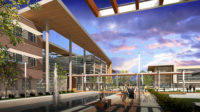Thanks to learning and growing over the years, Houston- based design firm PBK is the industry valedictorian in the education sector. The firm also encourages its industry partners and clients to learn in different ways as well.
Executive Chairman Dan Boggio founded PBK in 1981, and the company has expanded to 17 offices in Texas and California with 550-plus employees offering services including architecture, engineering, interior design, planning, technology and facilities consulting. Nine corporate divisions provide services including MEP, sports, civil, structural and education.
Through new contracts in 2020 and programs authorized by bonds and referendums from previous years, the firm’s regional revenue increased $17 million in 2020 to a company-high $143 million, up from $126 million in 2019. On the ENR Texas & Louisiana Top Design Firms ranking, this moved the company up three notches to 18th in 2021 from 21st in 2020.
Recently ranked the No. 1 education design firm by ENR, PBK has completed thousands of projects in the K-12 through college/university, health care, sports and corporate business sectors, mostly in Texas and California. The company has won more than 400 design awards.
In 2020, two expansions solidified the company’s status as the nation’s leader in learning center design. PBK merged with WLC, based in Rancho Cucamonga, Calif., and also acquired Fresno-based SIM Architects, both noted for educational designs statewide.
“Ours is a culture of growth not because we only want to be larger,” says Richard Chi, one of PBK’s three co- CEOs. “We wake up every day excited by what we do. As a firm, we want to make an impact on shaping the learning environment for our students and community.”

MEETING SPACES: The five-story Cypress- Fairbanks Independent School District administrative building will include a boardroom and a conference center. RENDERING COURTESY OF PBK
A Class by Itself
Clients and project team associates extol the firm’s history of community involvement, its adoption of alternative delivery systems and BIM technology and, in particular, its unparalleled focus on what PBK calls “obsessive client service.”
“As a firm, we want to make an impact on shaping the learning environment for our students and the community.”
—Richard Chi, Co-CEO, PBK
Contractor George Pontikes, who co-founded Houstonbased Satterfield & Pontikes Construction Inc. in 1989, had met Boggio six years earlier and was immediately impressed with his focus on clients’ needs—and later by PBK’s early use of CM at-risk and other alternative-delivery methods. Today, his company almost universally employs competitive sealed proposals for PBK school contracts.
“Dan and PBK were extremely collaborative even when hard bid was our only option,” Pontikes says. “But the transformation from that to alternative delivery methods has allowed his team to even better fulfill its focus on completing a project at the highest level for the client.” An ENR top 400 company, Satterfield & Pontikes has delivered at least 50 projects with PBK, Pontikes says.
In the same spirit, PBK has enthusiastically adopted technology such as Primavera, Revit and 3D modeling. “PBK has become one of the industry leaders,” Pontikes says.
Peter McElwain, who retired in January 2017 after serving the Katy ISD for 19 years as its district architect and planner, partnered with PBK on approximately 50 projects for the district, about 25 miles west of downtown Houston. “Every one of the projects was successful. In my 30 years in education, I have never worked with a company like PBK. There is a culture of excellence at all levels. They make you feel that you are their only client.”
Despite COVID-19 restrictions, PBK remains involved with a range of outreach efforts, including the ACE Mentor Program and Women in Architecture. In addition, PBK is the sole Angel Sponsor of Journeyman International, a nonprofit that designs green facilities and trains the next generation of humanitarian designers.
“Dan is extremely philanthropic,” Pontikes says. “He supports the community.”

SETTING THE STAGE: The Visual and Performing Arts Center for the Cypress- Fairbanks Independent School District will include a multilevel 1,500- seat auditorium. RENDERING COURTESY OF PBK
Pandemic 101 & 202
“One of the reasons 2020 was our largest year ever was that we responded quickly to the pandemic marketplace with needed services,” says Boggio.
In K–12 schools, for example, the company offered readying services for schools preparing for the return of students. These included disinfecting surfaces; affixing stickers on the floor for correctly distanced desk placement; strategically placing plastic shields at tables and in administrative spaces; and applying arrows or taping off a median strip in corridors to encourage one-way travel.
Air-flow enhancements included opening outside HVAC air dampers to optimize inside ventilation; installing MERV-13-rated filters and UV air-purification systems in ductwork; employing portable HEPA units where ventilation is limited; installing bipolar ionization technology to neutralize harmful pathogens; and using duct-mounted ultraviolet lights in some of the classrooms to eliminate contamination. In addition, LEAF Engineers, a PBK company, is working with client districts and performing indoor air quality assessment services to ensure classrooms are prepared for safe occupancy.
Throughout the pandemic, the firm has tested all improvements. Boggio says, “We have had no breakouts, and the scientific studies seem to suggest that they have made a difference.”
Building Good Projects Builds Good Students
Well-designed learning environments immerse students in the learning process. To accomplish this, PBK’s spaces include generous natural lighting. For instance, the $55.64-million College of the Mainland STEAM/Allied Health Building in Texas City, Texas, incorporates shaded east- and west-facing windows for letting in natural light and reducing heat gain. There is also a metal panel and curtain wall facing the lake for northern light and views. Comprising 169,000 sq ft on 79 acres, the three-story facility about 55 miles south of Houston was completed in February 2021 by Houston-based Austin Commercial.
The firm also designs learning spaces that are technologically rich and colorful and easily adaptable. “Pushing the next generation in learning are flexible environments so that students with different learning styles can be successful,” says Chi.
Natural environments do this, too, so outdoor classrooms are becoming increasingly popular, spurred by COVID-19 protocols for clean air and social distancing. These spaces encourage students to explore, collaborate outside and learn about indigenous flora. These green areas also further campus sustainability by absorbing water and carbon, mitigating stormwater and urban heat and providing wildlife habitats. Social equity, too, is served, as traditionally underserved urban populations experience nature and learn the importance of preservation.
Students exposed to green schoolyards show advances in critical thinking and improved test scores, and they are happier, have less stress and fewer discipline issues and are less susceptible to obesity, Chi says.
An example of a school focused on experiential learning and the outdoors is the $21.5-million Alief Early Childhood Center in Houston, begun in May 2021 by Satterfield & Pontikes. The 80,000-sq-ft project for prekindergarten and kindergarten students is scheduled to open in August 2022. Incorporating the golden ratio often found in the natural world as well as spiral elements, the nearly 20-acre campus is organized into two villages surrounding a central administrative building. The villages in turn contain three neighborhoods: Discovery, Inquiry and Voyage, each with four houses or experiences and a shared collaboration area.
The site features 190-plus trees and pocket prairies and comprises three diverse outdoor learning environments: interior courtyards for developing motor skills and encouraging play; backyards for outdoor classes and hands-on instruction; and exploration areas on the balance of the site.
An outdoor learning green is also a key component of another PBK/ Satterfield & Pontikes collaboration— the 112-acre Katy ISD Education Village. It houses the 628,154-sq-ft Jordan High School, completed for $138.22 million in June 2020, and the 198,815-sqft Joe M. Adams Junior High School, completed for $43.33 million in June 2019 by Drymalla Construction Co., Columbus, Texas. The campus is in the Cross Creek Ranch area of Katy.
The learning green connecting the two schools has outdoor education areas, a walking path, a covered teaching amphitheater and a shared green space that can also be used for outdoor dining and numerous educational opportunities.
“Our earlier shared-use campuses had the parking lots between the two schools, but Education Village embraces the outdoors by placing all of the parking around the perimeter of the schools,” McElwain says.
The $110-million Cypress-Fairbanks ISD Visual and Performing Arts Center and Instructional Support Center, again built by Satterfield & Pontikes, are scheduled for completion in December 2022 on a 26-acre site adjacent to the first district high school, built in 1935. The 225,000-sq-ft five-story support center will connect to the approximately 88,000-sq-ft arts center, which will serve the entire district.
“Both buildings are one of a kind for Cy-Fair. We have never built a support center or a visual and performing arts center, and they will be the centerpiece of the school district architecturally and geographically,” says Mark Henry, superintendent of the third-largest school district in Texas, which encompasses 186 square miles of northwest Harris County, including parts of Houston. “PBK has been the number-one architect for Cy-Fair ISD for two decades and unquestionably provides the best customer service and attention to detail in the education design industry.”
Designing the Post-COVID Campus
PBK is prepared for the future of education. COVID-19 has already influenced the design of learning facilities and become a catalyst for the next generation, Chi says.
For example, advanced sensors will continuously monitor the indoor air for health and wellness, and covered outdoor classrooms will have large monitors similar to those inside.
Traditional classrooms will be replaced with flexible configurations. Broadcast centers, for example, will provide live instruction to at-home students. “Teachers may be standing in front of multiple screens and see individual students working remotely,” Chi explains.
Boggio notes that the schools of the future may have no classrooms at all. PBK is discussing this with Google.
“We will be delivering education spaces and renovated spaces very different from the traditional model— not a teacher lecturing and giving a quiz every six weeks but perhaps small groups of students addressing realworld problems with the teacher as a guide,” he says.
“Education is in the midst of a sea change, and PBK will continue to be a part of that transformation.”





Post a comment to this article
Report Abusive Comment